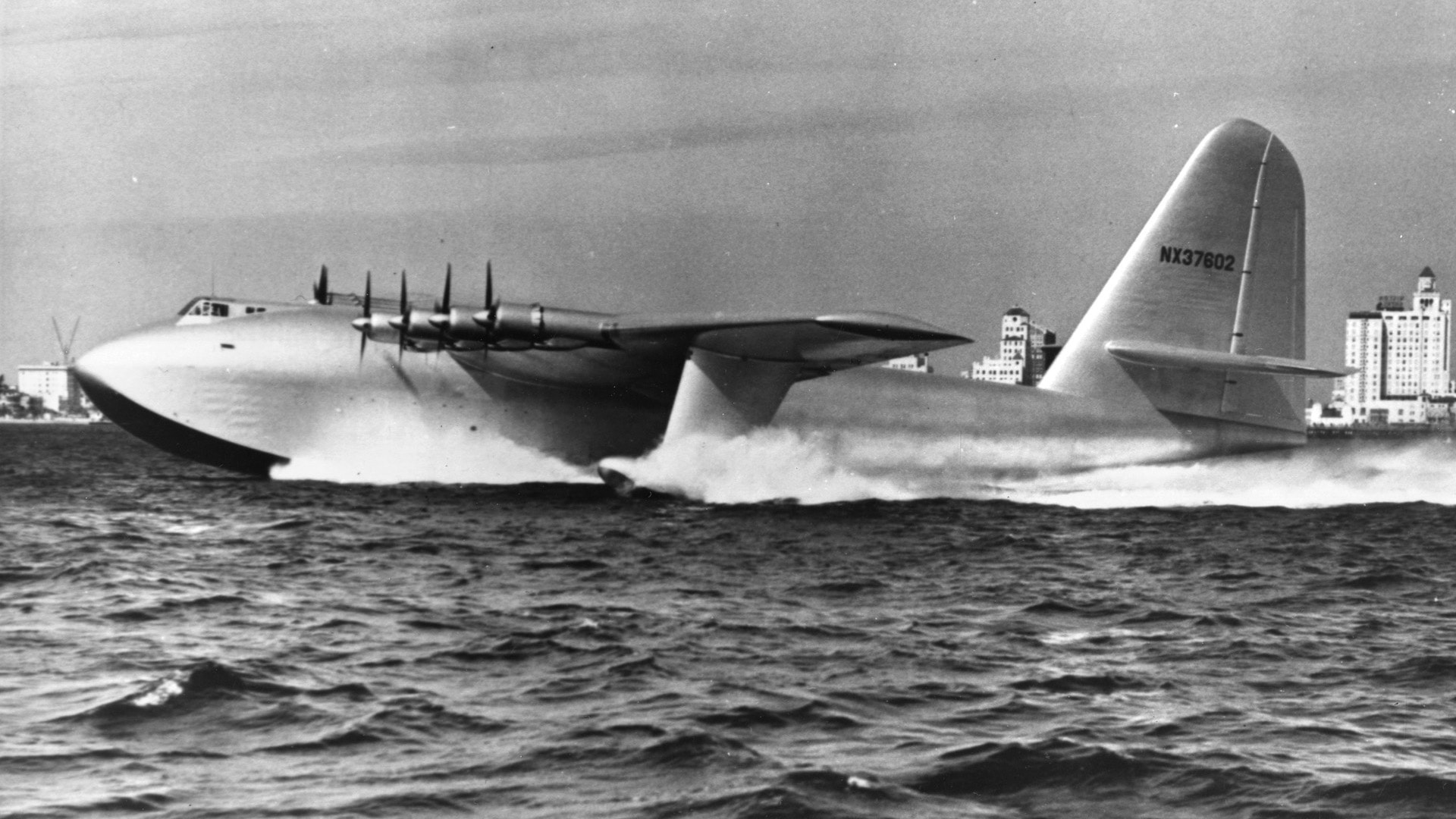Spruce Goose, a History: When one thinks of the name “Hercules” in the aviation context (as opposed to the eponymous original Greek god), one most likely thinks of the venerable C-130 Hercules, which is one of the members of an exclusive pantheon of U.S. military aircraft still in service after more than 50 years.
However, if you mention the name Hughes H-4 Hercules to all but the most hardcore aviation history buff, chances are you’ll get a blank stare.
More than likely, those same blank-staring eyes will light up with recognition when you provide the H-4’s far more famous name: the Spruce Goose, which to this day remains the largest propeller-driven airplane ever built.
Spruce Goose: Origins and Specifications
The Spruce Goose was, of course, the brainchild of the eccentric billionaire philanthropist and film producer Howard Hughes. More specifically, she was built under the auspices of Hughes Aircraft Company, which was founded by the tycoon in 1934 and lasted 63 years before being sold to Raytheon in 1997. Mr. Hughes had intended this Superbird as a transatlantic flight transport for use during the Second World War, with the idea of being able to avoid the ravages of Nazi German Kriegsmarine U-boats.
Alas, whilst the contract for the development of the giant plane was signed in November 1942, the Hercules wasn’t completed until 1947, two years after that war ended. The total cost came to $23 million USD, equivalent to $278M today.
The H-4 was built almost entirely of wood, specifically birch, and more specifically Duramold, a wood lamination process that produces strong plywood. The only non-wooden parts of the aircraft were the eight engines, along with the electronics, screws, and braces used in the restoration process.
Among the Herculean specifications: are a wingspan of 320 feet 11 inches, a wingspan of 218 feet 8 inches, a height of 79 feet 4 inches, and an empty weight of 300,000 pounds.
Her Lone Flight
It was Howard Hughes himself – an accomplished pilot who had twice set speed records in his racing aircraft – who was at the controls of his gargantuan Goose for her first and only flight. Departing out of Long Beach Harbor on the afternoon of November 2, 1947, Hughes managed to get her up for a total of 26 seconds, at an altitude of 33 feet above the surface of the water, covering a distance of half a mile at a speed of about 80 miles per hour.
So Then, Who’s Bigger?
As the saying goes, “You learn something new every day.” Until I finished doing the research for this article, I had been under the assumption that the Spruce Goose was still the largest aircraft of any kind ever built. It was the FAQ segment of the official website for the Evergreen Aviation & Space Museum that set me straight:
“The Spruce Goose held the title of the largest plane ever built until 2019, when the Stratolaunch jet took the record with a wingspan of 385 feet. The engineering team that constructed the jet used technology innovations first used when building the Spruce Goose back in 1947. The Stratolaunch jet had its most recent launch in April 2021 with the goal to eventually carry cargo or people into orbit. The Spruce Goose still holds the record for the largest seaplane, the largest wooden aircraft, and the largest propeller plane ever built.”
Speaking of the Stratolaunch, her own website provides some additional mind-blowing figures, such as a takeoff weight of 1.3 million pounds!
Seeing the Spruce Goose Up Close & Personal
‘Twas during my 5th-grade year in the spring of 1986 that I got to see the Spruce Goose in-person for the only time in my life, whilst she was still docked in the same segment of Long Beach Harbor as the RMS Queen Mary. (The latter historical attraction remains in “The LBC” and is a tour that I highly recommend, one that never gets old or boring.) At the time, the local L.A. TV stations were running some catchy adverts promoting both exhibits.
Suffice to say that as an impressionable 10-year old kid, seeing the legendary big bird with my own eyes was quite a sight to behold indeed. My only regret was not being able to make a second trip to see her before her eventual relocation away from Southern California.
Where Is She Now?
The Spruce Goose was removed from Long Beach Harbor in 1993. The disassembled parts were initially housed in McMinnville, Oregon, and remained there until the aforementioned Evergreen Museum’s Aviation Museum building was completed in 2001, whereupon the pieces were brought inside and reassembled by the museum’s Restoration Team.
As for the big white dome in Long Beach Harbor – built back in 1983 at a cost of $25 million USD – that used to host the plane?
It’s now a cruise ship terminal, and as a U.S. Customs & Border Protection (CBP) Officer assigned to L.A./Long Beach Seaport from 2006 to 2009, I performed many an inspection of cruise ship passengers, crew members, and their baggage at that spot. Long after the departure of the dome’s most famous occupant, the terminal still retained the “H-4” alphanumeric designation, but I never knew the story behind that label until I started the research for this article.
Christian D. Orr is a former Air Force Security Forces officer, Federal law enforcement officer, and private military contractor (with assignments worked in Iraq, the United Arab Emirates, Kosovo, Japan, Germany, and the Pentagon). Chris holds a B.A. in International Relations from the University of Southern California (USC) and an M.A. in Intelligence Studies (concentration in Terrorism Studies) from American Military University (AMU). He has also been published in The Daily Torch and The Journal of Intelligence and Cyber Security. Last but not least, he is a Companion of the Order of the Naval Order of the United States (NOUS).
From 19FortyFive

